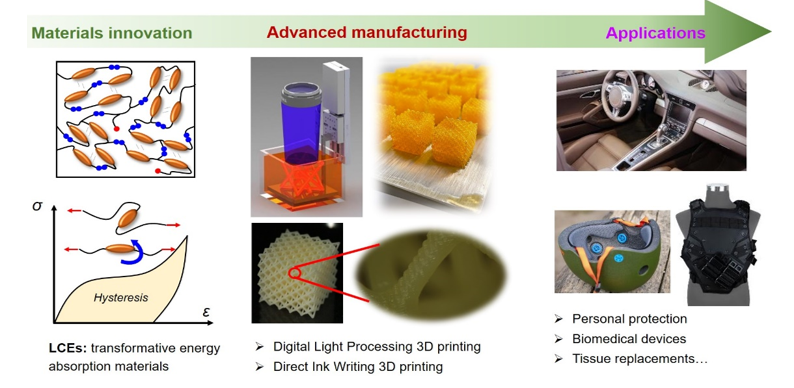Video Article Open Access
Enhanced Energy Dissipation of Liquid Crystal Elastomers and their 3D Printed Material Structures
Kai Yu1,*, Chaoqian Luo1, Nicholas Traugutt1, Devesh Mistry1, Christopher Yakacki1, Kevin N. Long2
1Department of Mechanical Engineering, University of Colorado Denver, Denver, 80204, USA
2Materials and Failure Modeling Department, Sandia National Laboratories, Albuquerque, 87185, USA
Vid. Proc. Adv. Mater., Volume 3, Article ID 2208306 (2022)
DOI: 10.5185/vpoam.2022.08306
Publication Date (Web): 21 Oct 2022
Copyright © IAAM
Graphical Abstract

Abstract
Polymer foams are an important class of lightweight materials used to protect assets against mechanical insult (shock and vibration), and they are used across many engineering disciplines including automotive, aerospace, biomedical, and safety equipment. Against mechanical shock, compaction of the foam microstructure absorbs energy and limits the transfer of load to the protected asset. Two features of the foam are important to enhance its energy absorption characteristics: the foam micro (or meso) structure and the matrix phase mechanical behavior. We investigate here novel approaches towards both of these controlling features. First, we consider 3D printing via Digital Light Processing as a method to carefully control foam meso-structure and explore here a suite of periodic lattices structures to demonstrate that we can carefully control foam meso-structure in space. But, instead of printing conventional thermoset polymers for the matrix phase, we investigate the energy dissipation capability of 3D-printed liquid crystal elastomer (LCE) foams. LCEs represent a transformative energy absorption material with mesogens (two-three benzene rings) built on the chain backbone. In addition to the viscoelastic relaxation of polymer chains, the mechanically-induced phase transition and mesogen rotation of LCEs provide an additional mechanism for energy dissipation. A new photocurable thiol-acrylate LCE resin is optimized for digital light processing (DLP) printing. In both quasi-static and dynamic loading conditions, the lattices show dramatically enhanced energy dissipation in uniaxial compression compared to the non-LCE foams printed with a commercially available photocurable elastomer resin. The lattice geometry also plays a prominent role in determining the energy dissipation ratio. It is shown that when increasing the lattice connectivity, the deformation is translated from bending-dominated to stretching-dominated, which generates higher axial strain in the struts and higher energy dissipation of the lattice. The presented work plays a significant role in exploiting the potential of 3D printing with advanced polymer materials for the next generation of protective foams.
Keywords
Liquid crystal elastomer; additive manufacturing; lattice foam; energy dissipation.
Acknowledgement
Kai Yu acknowledges the support from the Laboratory Directed Research and Development program at Sandia National Laboratories, a multi-mission laboratory managed and operated by National Technology and Engineering Solutions of Sandia LLC, a wholly owned subsidiary of Honeywell International Inc. for the U.S. Department of Energy’s National Nuclear Security Administration under contract DE-NA0003525. Kai Yu acknowledges support from the National Science Foundation (CAREER Award CMMI-2046611).
Biography
Kai Yu currently is an Assistant Professor in Mechanical Engineering at the University of Colorado Denver. He got his Ph.D. degree in the George W. Woodruff School of Mechanical Engineering at Georgia Institute of Technology in the August of 2015. Prior, he studied at the University of Colorado Boulder and received his Bachelor’s degree in Engineering Mechanics from Harbin Institute of Technology (China) in 2008. Dr. Yu’s research focuses on the mechanical and physical behavior of contemporary active polymers that are important to the nation, such as reprocessable and recyclable plastics, liquid crystal elastomers, and shape-changing polymers. He is interested in understanding and modeling the evolution of material structure and mechanical properties under various environmental stimuli and processing conditions using an integrated experimental-theoretical-computational approach. His research work aims to facilitate applications of these materials into advanced manufacturing and material processing technologies (e.g., 3D and 4D printing, chemical recycling). To date, Dr. Yu and his research team have published over ninety peer-reviewed journal papers. His research works are supported by various funding agencies, including the National Science Foundation (NSF), Airforce Office of Scientific Research, Office of Naval Research, Department of Energy, etc. He is the recipient of the prestigious NSF CAREER Award in 2021, and the Outstanding Faculty in Engineering Research at the University of Colorado Denver in 2020 and 2022.
Video Proceedings of Advanced Materials

Upcoming Congress



